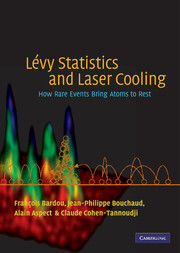Book contents
- Frontmatter
- Contents
- Foreword
- Acknowledgements
- 1 Introduction
- 2 Subrecoil laser cooling and anomalous random walks
- 3 Trapping and recycling. Statistical properties
- 4 Broad distributions and Lévy statistics: a brief overview
- 5 The proportion of atoms trapped in quasi-dark states
- 6 The momentum distribution
- 7 Physical discussion
- 8 Tests of the statistical approach
- 9 Example of application: optimization of the peak of cooled atoms
- 10 Conclusion
- Appendix A Correspondence between parameters of the statistical models and atomic and laser parameters
- Appendix B The Doppler case
- Appendix C The special case µ = 1
- References
- Index of main notation
- Index
7 - Physical discussion
Published online by Cambridge University Press: 06 July 2010
- Frontmatter
- Contents
- Foreword
- Acknowledgements
- 1 Introduction
- 2 Subrecoil laser cooling and anomalous random walks
- 3 Trapping and recycling. Statistical properties
- 4 Broad distributions and Lévy statistics: a brief overview
- 5 The proportion of atoms trapped in quasi-dark states
- 6 The momentum distribution
- 7 Physical discussion
- 8 Tests of the statistical approach
- 9 Example of application: optimization of the peak of cooled atoms
- 10 Conclusion
- Appendix A Correspondence between parameters of the statistical models and atomic and laser parameters
- Appendix B The Doppler case
- Appendix C The special case µ = 1
- References
- Index of main notation
- Index
Summary
In the previous chapters, several important quantities characterizing the cooled atoms have been introduced and calculated. We now discuss the physical content of these results. We first show (Section 7.1) that the momentum distribution (p, θ) can be interpreted as the solution of a rate equation describing competition between rate of entry and rate of departure. This provides a new insight into the sprinkling distribution SR(t) which appears as a ‘source term’ for the trapped atoms. We then consider the tails of the momentum distribution (Section 7.2) and we show that they appear as a steady-state or ‘quasi-steady’-state solution of the rate equation describing the evolution of the momentum distribution. On the contrary, in the central part of this distribution, atoms do not have the time to reach a steady-state or a quasi-steady-state because their characteristic evolution times are longer than the observation time θ. One can understand in this way the θ-dependence of the height of the peak of the cooled atoms (Section 7.3). We also investigate (Section 7.4) the important case where the jump rate R(p) does not exactly vanish when p = 0 and we show that, when θ is increased, there is a cross-over between a regime where Lévy statistics is relevant, as in the previous case, and a regime where a true steady-state can be reached for the whole momentum distribution.
- Type
- Chapter
- Information
- Lévy Statistics and Laser CoolingHow Rare Events Bring Atoms to Rest, pp. 88 - 100Publisher: Cambridge University PressPrint publication year: 2001



